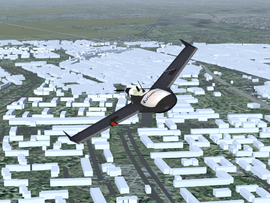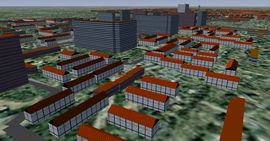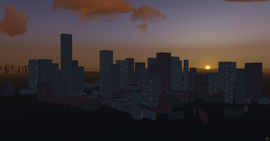OpenStreetMap buildings: Difference between revisions
Jump to navigation
Jump to search
(Gable roofs image) |
(Shapefiles not coming from osm can be used as well!) |
||
| Line 9: | Line 9: | ||
=== Note for Windows === | === Note for Windows === | ||
Windows does not contain perl by default. You're advised to install [http://strawberryperl.com/ Strawberry Perl for Windows]. It is a simple installer; no need to dig into your system. | * Windows does not contain perl by default. You're advised to install [http://strawberryperl.com/ Strawberry Perl for Windows]. It is a simple installer; no need to dig into your system. | ||
* [http://www.cygwin.com/ Cygwin] is also advised, so "grep" can be used to get a list of building ids easily. | |||
* When working with shapefiles not coming from OSM you will need ogr2ogr, which is included in [http://fwtools.maptools.org/ FWTools]. | |||
== From OpenStreetMap == | |||
=== A single building === | |||
== A single building == | |||
# Find the building in OpenStreetMap. | # Find the building in OpenStreetMap. | ||
# Enable the "Data" overlay. | # Enable the "Data" overlay. | ||
| Line 28: | Line 29: | ||
::* '''Building height''' (in meters): | ::* '''Building height''' (in meters): | ||
:::: <code>-h 15</code> | :::: <code>-h 15</code> | ||
:::: '''Note:''' buildings are always sunk 5 m into the ground, in order to account for non-flat terrain. | :::: '''Note:''' buildings are always sunk 5 m into the ground, in order to account for non-flat terrain. These 5 meters are added on top of (or below, if you like) the building height. | ||
::* '''Create a xml file''' with a standard range animation: | ::* '''Create a xml file''' with a standard range animation: | ||
:::: <code>-x</code> | :::: <code>-x</code> | ||
== All buildings in an area == | === All buildings in an area === | ||
[[File:New York with OSM buildings dawn.png|thumb|270px|Lower Manhattan at dawn.]] | [[File:New York with OSM buildings dawn.png|thumb|270px|Lower Manhattan at dawn.]] | ||
# Download a file with all data from the area, by visiting the following link and save it somewhere on your computer. This will only include buildings (building=yes) within the specified bounding box. | # Download a file with all data from the area, by visiting the following link and save it somewhere on your computer. This will only include buildings (building=yes) within the specified bounding box. | ||
#: <code><nowiki>http://overpass-api.de/api/xapi?way[bbox=left,bottom,right,top][building=*][@meta]</nowiki></code> | #: <code><nowiki>http://overpass-api.de/api/xapi?way[bbox=left,bottom,right,top][building=*][@meta]</nowiki></code> | ||
#: <code><nowiki>http://overpass-api.de/api/xapi?way[bbox=-74.02037,40.69704,-73.96922,40.73971][building=*][@meta]</nowiki></code> | #: <code><nowiki>http://overpass-api.de/api/xapi?way[bbox=-74.02037,40.69704,-73.96922,40.73971][building=*][@meta]</nowiki></code> | ||
# Get a list of wayids via <code>grep "<way" map.osm|cut -f2 -d\">file.txt</code> | |||
# Run <code>perl bob.pl -w $object -f map.osm</code> on all the ids. | |||
== From another source == | |||
# Run ogr2ogr with: | |||
#: <code><nowiki>ogr2ogr -t_srs WGS84 -s_srs "ESRI::in_shp.prj" "out_shp.shp" "in_shp.shp"</nowiki></code> | |||
# Run [http://wiki.openstreetmap.org/wiki/Shp2osm shp2osm] with: | |||
#: <code><nowiki>shp2osm.pl "out_shp.shp" > "map.osm"</nowiki></code> | |||
# Get a list of wayids via <code>grep "<way" map.osm|cut -f2 -d\">file.txt</code> | # Get a list of wayids via <code>grep "<way" map.osm|cut -f2 -d\">file.txt</code> | ||
# Run <code>perl bob.pl -w $object -f map.osm</code> on all the ids. | # Run <code>perl bob.pl -w $object -f map.osm</code> on all the ids. | ||
Revision as of 11:25, 10 April 2012
| Work in progress This article or section will be worked on in the upcoming hours or days. See history for the latest developments. |
Buildings can be mapped in OpenStreetMap. Their shapes can be turned into 3D models for use in FlightGear scenery.
Tools
A perl script is being written to turn the OSM data into 3D models. It is available at https://gitorious.org/fgscenery/tools.
Note for Windows
- Windows does not contain perl by default. You're advised to install Strawberry Perl for Windows. It is a simple installer; no need to dig into your system.
- Cygwin is also advised, so "grep" can be used to get a list of building ids easily.
- When working with shapefiles not coming from OSM you will need ogr2ogr, which is included in FWTools.
From OpenStreetMap
A single building
- Find the building in OpenStreetMap.
- Enable the "Data" overlay.
- Choose a manual area and drag a box around your building.
- Click your building, the way id will be shown. Copy this id.
- Run the following code, replacing 44338398 with your building's id:
perl bob.pl -w 44338398
- Next to this basic code, there are several options, to be added behind the basic code.
- Lat/lon location of the model's origin:
-lat 52.00141 -lon 4.36966
- Object name (not the .ac name!):
-n "Empire State Building"
- Building height (in meters):
-h 15- Note: buildings are always sunk 5 m into the ground, in order to account for non-flat terrain. These 5 meters are added on top of (or below, if you like) the building height.
- Create a xml file with a standard range animation:
-x
- Next to this basic code, there are several options, to be added behind the basic code.
All buildings in an area
- Download a file with all data from the area, by visiting the following link and save it somewhere on your computer. This will only include buildings (building=yes) within the specified bounding box.
http://overpass-api.de/api/xapi?way[bbox=left,bottom,right,top][building=*][@meta]http://overpass-api.de/api/xapi?way[bbox=-74.02037,40.69704,-73.96922,40.73971][building=*][@meta]
- Get a list of wayids via
grep "<way" map.osm|cut -f2 -d\">file.txt - Run
perl bob.pl -w $object -f map.osmon all the ids.
From another source
- Run ogr2ogr with:
ogr2ogr -t_srs WGS84 -s_srs "ESRI::in_shp.prj" "out_shp.shp" "in_shp.shp"
- Run shp2osm with:
shp2osm.pl "out_shp.shp" > "map.osm"
- Get a list of wayids via
grep "<way" map.osm|cut -f2 -d\">file.txt - Run
perl bob.pl -w $object -f map.osmon all the ids.
External links
- Building attributes (OSM wiki)
- Roof type Library (OSM wiki)


